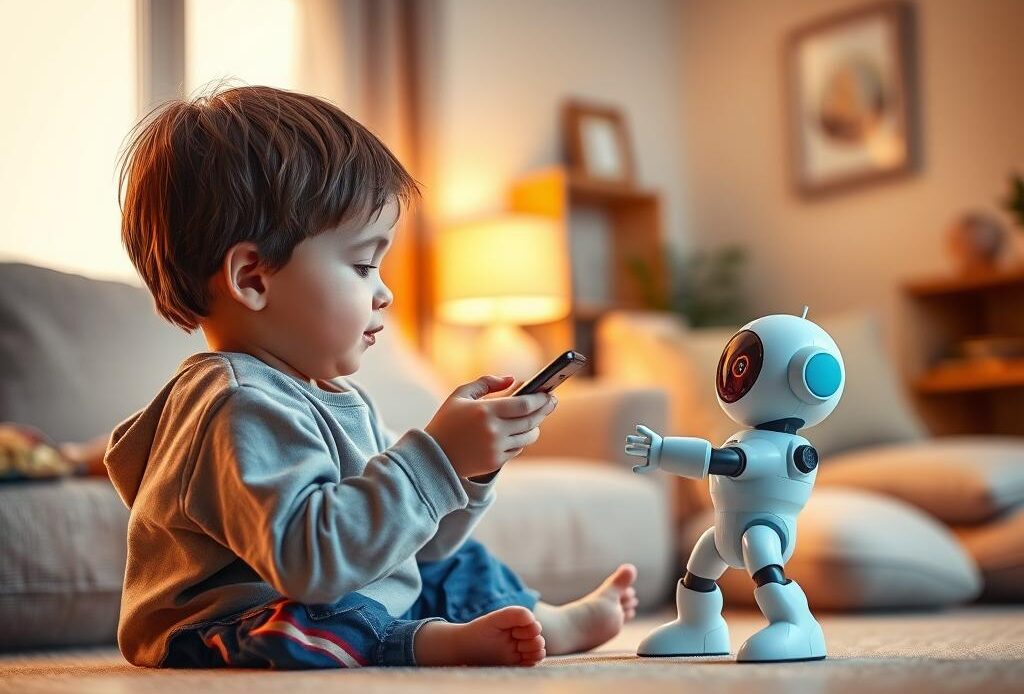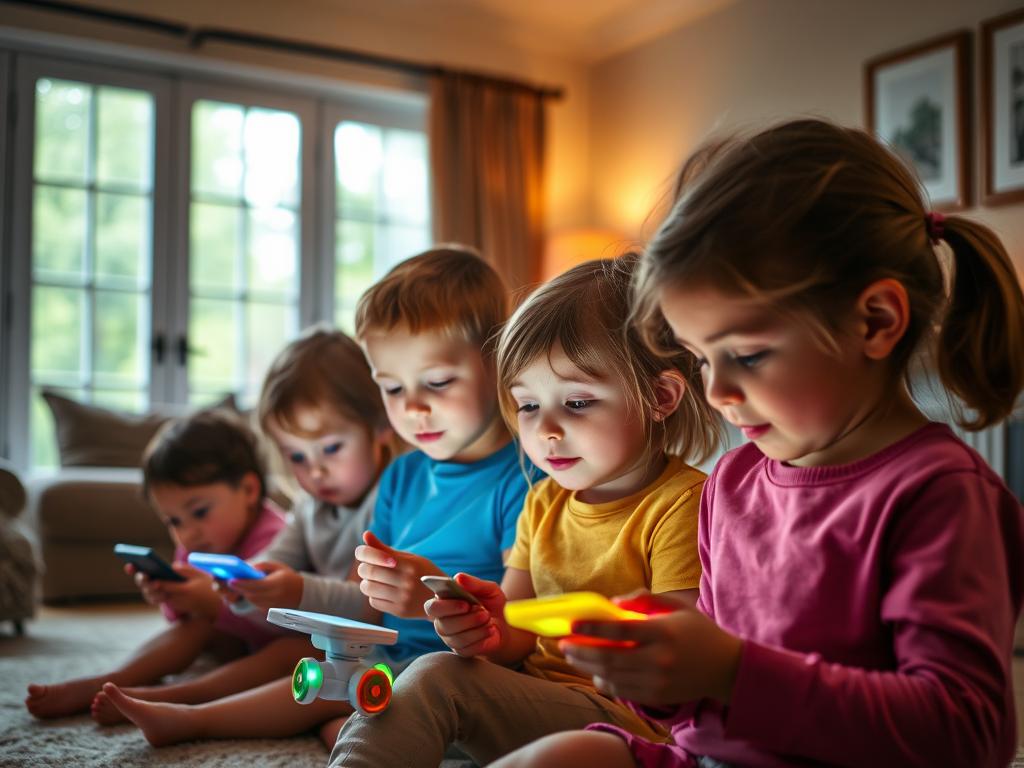
As app-controlled toys become increasingly popular in children’s playrooms, parents are faced with new challenges in ensuring their kids’ safety during playtime. These modern toys combine physical play with digital interfaces, introducing unique safety considerations that didn’t exist with traditional toys.
To keep children safe, it’s crucial to address both physical safety concerns, such as batteries and small parts, and digital safety concerns, including data privacy and security. By understanding these risks and taking proactive steps, parents can create a safer environment for their kids to enjoy the benefits of these innovative toys.
Key Takeaways
- Understand the unique safety considerations of app-controlled toys.
- Learn how to update traditional toy safety guidelines for connected devices.
- Identify both physical and digital safety concerns associated with these toys.
- Discover practical advice for ensuring children’s safety during playtime.
- Navigate the world of app-controlled toys with confidence.
Understanding App-Controlled Toys and Their Risks
App-controlled toys combine physical play with digital interaction, creating a new category of toys that come with distinct safety challenges. These toys are not just simple playthings; they integrate technology to offer interactive experiences.
What Makes App-Controlled Toys Different
Unlike traditional toys, app-controlled toys merge physical objects with digital interfaces. This combination creates unique safety considerations that parents need to understand. The dual nature of these toys means they have both the physical safety concerns of regular toys and the digital security and privacy risks associated with connected devices.
Common Safety Concerns with Connected Toys
Connected toys often collect data, require internet access, and may have cameras or microphones, raising significant privacy concerns for children and families. Additionally, physical hazards such as battery compartments, charging cables, and electronic components pose risks to young children. According to the U.S. Consumer Product Safety Commission, an estimated 200,000 toy-related injuries were treated in U.S. hospital emergency departments in 2020, with most patients being children 4 years old or younger.
Essential App Toy Safety Tips for Parents
To ensure a safe and enjoyable experience for your child, it’s essential to follow key safety tips for app-controlled toys. As a parent, you play a crucial role in safeguarding your child’s interaction with these innovative products.
Researching Before Purchasing
Before buying an app-controlled toy, it’s vital to conduct thorough research. This includes checking reviews from other parents, understanding the toy’s privacy policy, and investigating the manufacturer’s reputation. Look for toys from trusted brands that have a history of producing safe and reliable products.
- Check online reviews and ratings to gauge the toy’s performance and safety.
- Understand what data the toy collects and how it’s used.
- Research the manufacturer’s reputation for producing safe products.
Understanding Age Recommendations
Always check the age recommendation on the toy packaging. These guidelines are based on the developmental needs and safety considerations of various age groups. A toy suitable for a toddler might pose risks for an infant. Age recommendations are there to help you make an informed decision.
Checking for Trusted Brands and Certifications
Identifying trusted brands and looking for safety certifications is crucial. Organizations like the Consumer Product Safety Commission (CPSC) certify toys that meet established safety standards. Ensure the toy has the necessary certifications before making a purchase.
By following these essential safety tips, you can significantly reduce the risks associated with app-controlled toys and provide a safer environment for your child to enjoy their new toy.
Physical Safety Considerations
When it comes to app-controlled toys, physical safety is just as crucial as digital security. Ensuring that these toys are safe for children to use is a top priority for parents.
Inspecting for Sharp Edges and Small Parts
Toys should be free from sharp edges or protruding points that can cause cuts or injuries. It’s also crucial to check for small parts that could pose a choking hazard. We recommend thoroughly inspecting app-controlled toys before giving them to children.
Battery Compartment Security
App-controlled toys often contain lithium batteries, which can be extremely dangerous if swallowed or damaged. Ensuring that the battery compartments are secure is vital. For more information on the risks associated with certain toys, you can refer to this case study on child toys.
Proper Charging Practices
To maintain toy safety, it’s essential to follow proper charging practices. This includes using only manufacturer-approved chargers and supervising charging sessions. Children should be taught never to use toys while they’re charging to prevent potential injuries.
Digital Security and Privacy Protection
With the growing popularity of connected toys, parents must be aware of the potential digital risks associated with them. As we navigate the world of app-controlled toys, it’s essential to prioritize our children’s digital security and privacy.
Understanding App Permissions
One crucial step in safeguarding our children’s digital security is understanding the permissions granted to toy apps. We must be aware of the data these apps collect, including location data, photos, or recordings, which could potentially compromise our child’s privacy. When installing an app for a connected toy, we should carefully review the permissions requested and consider whether they are necessary for the toy’s functionality.
Securing Wi-Fi Connections
Securing our home Wi-Fi network is another vital aspect of protecting our children’s digital security. We can achieve this by using strong, unique passwords and enabling WPA3 encryption. This helps prevent unauthorized access to our connected toys, which could potentially be used to communicate with our child.
Protecting Personal Information
To protect our child’s personal information, we should use nicknames instead of real names in profiles and be cautious about sharing photos or videos through toy apps. It’s also essential to educate our children about digital privacy in an age-appropriate manner, teaching them what information is safe to share and what should remain private.

- Be mindful of the data collected by toy apps and review permissions carefully.
- Secure your home Wi-Fi network with strong passwords and WPA3 encryption.
- Use nicknames in profiles and be cautious when sharing content through toy apps.
Setting Up Parental Controls
As parents, setting up parental controls on app-controlled toys is a crucial step in ensuring our children’s safety during playtime. By doing so, we can create a safer and more controlled environment for our kids to enjoy their toys.
Limiting Screen Time
One of the key aspects of parental controls is limiting screen time. App-controlled toys often require a connected device, such as a smartphone or tablet, which can expose children to excessive screen time. To make sure your child maintains a healthy balance between digital and traditional play, you can set time limits on the app or device.
Content Restrictions
Another critical aspect is implementing content restrictions. Many app-controlled toys offer additional content through their connected apps, some of which may not be suitable for young children. By setting content restrictions, you can prevent your child from accessing inappropriate material.
In-App Purchase Protection
In-app purchases can be a concern with connected toys. To protect against unauthorized purchases, you can usually set up a password or PIN requirement within the app’s settings. This ensures that only authorized adults can make purchases.
- Regularly review and update parental control settings as your child grows.
- Use the device or app’s built-in parental control features.
- Monitor your child’s activity to ensure the controls are effective.
Supervising App-Controlled Playtime
To ensure safe play, it’s essential to oversee our children’s interactions with app-controlled toys, especially during their first experiences. Supervision is key to preventing potential risks and teaching children how to use these toys responsibly.
Balancing Independence with Oversight
We need to find a delicate balance between giving our children independence with their app-controlled toys and maintaining appropriate oversight for safety. This balance allows children to explore and learn while minimizing risks.

Teaching Children Safe Usage Habits
By actively supervising our children, we can teach them safe usage habits, including proper handling of electronic components and responsible online behavior. As one expert puts it,
“Children learn from what they live.”
Thus, it’s crucial to model safe behavior when using app-controlled toys.
Recognizing Warning Signs of Unsafe Play
Parents should be aware of warning signs that might indicate unsafe play, such as unusual communications or attempts to bypass parental controls. By being vigilant, we can address these issues promptly and ensure our children’s safety.
Maintaining and Updating App-Controlled Toys
To ensure the longevity and safety of app-controlled toys, regular maintenance is crucial. As we discussed in previous sections, app-controlled toys offer a unique play experience, but they also come with unique challenges. Proper maintenance not only extends the life of these toys but also ensures they remain safe for our children to use.
Regular Toy Inspections
Regular inspections are vital to identify any potential issues with app-controlled toys. We should check for sharp edges that may have developed, loose small parts that could become choking hazards, or compromised battery compartments. For instance, a toy that has been dropped may have sustained damage that isn’t immediately visible. By regularly inspecting these toys, we can prevent accidents and ensure they remain safe for playtime.
Keeping Apps and Firmware Updated
Keeping the apps and firmware of app-controlled toys updated is critical for security. Updates often include patches for vulnerabilities that could be exploited, compromising our child’s safety or privacy. We should regularly check for updates and install them promptly to ensure our child’s safety. For more information on safe toys and gifts, you can visit Safe Toys and Gifts for the.
Proper Cleaning and Storage
App-controlled toys require special care when it comes to cleaning and storage. For toys that can’t be washed, we should use disinfecting sprays or wipes to keep them clean, especially during cold and flu season. When storing these toys, it’s advisable to remove batteries to prevent corrosion and consider using a toy box with no lid or a lightweight lid to prevent accidents. Proper storage also involves keeping all components together to avoid losing parts.
By following these guidelines, we can ensure that our children’s app-controlled toys remain safe, functional, and enjoyable for a long time.
Conclusion: Balancing Fun and Safety in the Digital Age
As we navigate the complex world of app-controlled toys, it’s clear that safety and fun are not mutually exclusive. To ensure a safe and enjoyable experience for children, parents must consider both traditional toy safety concerns and new digital safety measures. This includes selecting age-appropriate toys, regularly inspecting for sharp edges and small parts, and supervising playtime to prevent injuries and choking hazards. Additionally, utilizing tools like the toilet paper roll test for identifying choking hazards and checking for safety commission certifications can be beneficial. By staying informed about product safety updates and recall notices, parents can provide a safe and enriching play environment. With proper precautions, app-controlled toys can be a valuable addition to children’s playtime, offering a balance between digital and traditional play.
FAQ
What are some common hazards associated with app-controlled toys?
We should be aware that small parts and sharp edges can be a choking hazard or cause injuries to our little ones. Additionally, long cords and strings can be a strangulation risk.
How can we ensure our child’s app-controlled toy is safe to use?
We should always check for trusted brands and certifications from reputable organizations, such as the Consumer Product Safety Commission. We should also research the product before purchasing and read reviews from other parents.
What should we do to protect our child’s personal information when using app-controlled toys?
We need to understand app permissions and ensure that we are securing our Wi-Fi connections. We should also be cautious about the personal information we share and teach our children about online privacy protection.
Can we use a toilet paper roll to check for choking hazards in toys?
Yes, we can use a toilet paper roll as a rough guide to check if a small part can be a choking hazard. If the part fits inside the roll, it may be a choking hazard for our young children.
How often should we inspect our child’s app-controlled toys for damage?
We should regularly inspect our child’s toys for sharp edges, small parts, and other hazards. We should also check for any damage to the battery compartment and ensure that it is secure.

